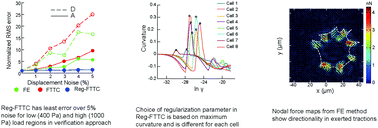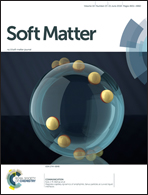Traction cytometry: regularization in the Fourier approach and comparisons with finite element method†
Abstract
Traction forces exerted by adherent cells are quantified using displacements of embedded markers on polyacrylamide substrates due to cell contractility. Fourier Transform Traction Cytometry (FTTC) is widely used to calculate tractions but has inherent limitations due to errors in the displacement fields; these are mitigated through a regularization parameter (γ) in the Reg-FTTC method. An alternate finite element (FE) approach computes tractions on a domain using known boundary conditions. Robust verification and recovery studies are lacking but essential in assessing the accuracy and noise sensitivity of the traction solutions from the different methods. We implemented the L2 regularization method and defined a maximum curvature point in the traction with γ plot as the optimal regularization parameter (γ*) in the Reg-FTTC approach. Traction reconstructions using γ* yield accurate values of low and maximum tractions (Tmax) in the presence of up to 5% noise. Reg-FTTC is hence a clear improvement over the FTTC method but is inadequate to reconstruct low stresses such as those at nascent focal adhesions. FE, implemented using a node-by-node comparison, showed an intermediate reconstruction compared to Reg-FTTC. We performed experiments using mouse embryonic fibroblast (MEF) and compared results between these approaches. Tractions from FTTC and FE showed differences of ∼92% and 22% as compared to Reg-FTTC. Selection of an optimum value of γ for each cell reduced variability in the computed tractions as compared to using a single value of γ for all the MEF cells in this study.



 Please wait while we load your content...
Please wait while we load your content...